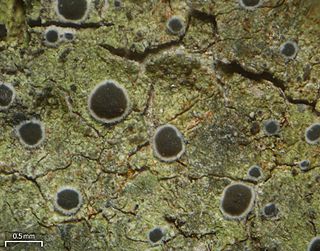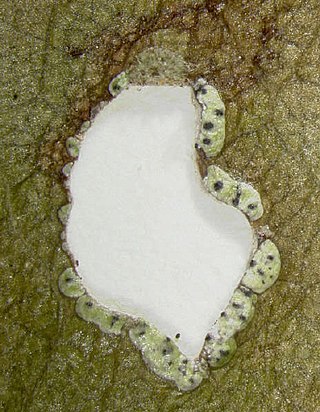Lasioloma is a genus of lichenized fungi in the family Pilocarpaceae. The genus was circumscribed by Swedish lichenologist Rolf Santesson in 1952, with Lasioloma arachnoideum assigned as the type species. Found predominantly in tropical rainforests, genus Lasioloma contains both foliicolous (leaf-dwelling) and corticolous (bark-dwelling) species. The foliicolous species are distinguished by their woolly prothallus, a thallus that ranges from dispersed to continuous, and a hairy apothecial margin. In contrast, corticolous species typically do not have a woolly prothallus, and their thalli are usually continuous, or unbroken. Regardless of the substrate they inhabit, all known Lasioloma species are characterized by the production of campylidia and branched conidia.

Byssoloma is a genus of leaf-dwelling lichens in the family Pilocarpaceae.
Ferraroa is a single-species genus in the family Gomphillaceae. It is a monotypic genus, containing the single species Ferraroa hyalina, a foliicolous (leaf-dwelling) lichen. This species was originally described by Robert Lücking in 1997 as Gyalideopsis hyalina. The type specimen was collected from leaves of Inga oerstediana in Costa Rica. Lücking, Emmanuël Sérusiaux, and Antonín Vězda transferred the taxon to the newly circumscribed genus Ferraroa in 2005 after molecular phylogenetic analysis showed it to belong to a unique lineage. The generic name Ferraroa honours Argentinian lichenologist Lidia Itatí Ferraro, "for her many contributions to lichenology in southern South America, and to our knowledge of Gomphillaceae".
Tarbertia is a single-species fungal genus in the order Arthoniales. The genus has not been placed into a family. This monotypic genus contains the species Tarbertia juncina.

Strigulaceae is a family of lichen-forming fungi, one of two families in the order Strigulales. Recent (2020) molecular analysis of the type genus, Strigula, has led to a reallocation of the foliicolous species into six genera that correspond to well-delimited clades with diagnostic phenotype features.

Strigula is a genus of lichen-forming fungi in the family Strigulaceae. The genus was circumscribed in 1823 by English mycologist Elias Magnus Fries.
Serusiauxiella is a genus of leaf-dwelling lichens in the family Strigulaceae. It has three species, all of which are found in wet tropical forests in China. The genus was circumscribed in 2020 by Shu-Hua Jiang, Robert Lücking, and Jiang-Chu Wei, with Serusiauxiella filifera assigned as the type species. The genus name honours Belgian lichenologist Emmanuël Sérusiaux, "in recognition of his important contributions to lichenology, foliicolous lichens and the genus Strigula".
Byssoloma brunneodiscum is a species of foliicolous (leaf-dwelling) lichen in the family Pilocarpaceae. Found in China, it was formally described as a new species in 2020 by Wei-Cheng Wang and Jiang-Chun Wei. The type specimen was collected by Wang in the Mingfeng Valley of Jianfeng Ridge at an altitude of 960 m (3,150 ft). It is only known to occur at high-altitude rainforests on Hainan Island, where it grows sparsely on leaf surfaces in the damp understorey. The specific epithet brunneodiscum refers to the brown discs that are characteristic of the apothecia of this species. The lichen makes 2,5,7-trichloro-3-O-methylnorlichexanthone, a secondary chemical that is detectable using thin-layer chromatography. Byssoloma annuum is similar in appearance and chemistry, but is distinguished from B. brunneodiscum by its orange-yellow apothecia and colourless hypothecium.
Phylloblastia is a genus of foliicolous (leaf-dwelling) lichens in the family Verrucariaceae. The genus was circumscribed in 1921 by Finnish lichenologist Edvard August Vainio, with Phylloblastia dolichospora assigned as the type species.

Strigulales is an order of lichen-forming fungi in the class Dothideomycetes. It contains two families: Strigulaceae and Tenuitholiascaceae, with a combined total of 115 species. The order was proposed by Robert Lücking, Matthew Nelsen, and Kevin Hyde in 2013. Most species in the order are foliicolous, that is, they grow on plant leaves.
Phylloblastia inexpectata is a species of foliicolous (leaf-dwelling) lichen in the family Verrucariaceae. Found in Europe, it was formally described by lichenologists Emmanuël Sérusiaux, Brian John Coppins, and Robert Lücking. The type specimen was collected by the second author in Dunskey Glen Woods, where it was found growing on the leaves of a Prunus laurocerasus tree growing near a stream. It has also been collected in England, southern Italy, Madeira, and Spain.
Swinscowia is a genus of lichen-forming fungi in the family Strigulaceae. It has 34 species. Swinscowia was proposed in 2020 by lichenologists Shu-Hua Jiang, Robert Lücking, and Emmanuël Sérusiaux to contain non-foliicolous species that were isolated from bark and rocks. Swinscowia jamesii, a species that was originally described in genus Geisleria, and later transferred to Strigula, is the type species of the genus. The genus name honours British lichenologist Dougal Swinscow, who originally described the type species in 1967.
Calenia lueckingii is a species of foliicolous (leaf-dwelling) lichen in the family Gomphillaceae. It was formally described as a new species in 1996 by Claudia Hartmann. The type specimen was collected by the author from the edge of Braulio Carrillo National Park in Costa Rica; there it was found growing on the leaves of Ardisia in a tropical wet transition rainforest. The species epithet honours German lichenologist Robert Lücking. In 2018, the lichen was recorded from Hainan, China.
Gyalideopsis sessilis is a species of foliicolous (leaf-dwelling) lichen in the family Gomphillaceae. Found in Florida, it was formally described as a new species in 2015 by lichenologists William Sanders and Robert Lücking.
Tapellaria parvimuriformis is a species of foliicolous (leaf-dwelling), crustose lichen in the family Pilocarpaceae. It is found in Thailand's Khao Yai National Park, where it grows in the shady understory of lowland rainforests.
Fouragea is a genus of lichen-forming fungi in the family Opegraphaceae. It has nine species.
Podotara is a fungal genus in the family Pilocarpaceae. It is a monotypic genus, containing the single species Podotara pilophoriformis, an uncommon foliicolous (leaf-dwelling), crustose lichen that grows on Podocarpus totara, a species of podocarp tree endemic to New Zealand. Both the genus and the species were proposed in 1996.
Macroconstrictolumina is a genus of lichen-forming fungi in the family Trypetheliaceae. It has four species.
Fellhanera ivoriensis is a species of foliicolous (leaf-dwelling) lichen. First described in 2001, this species is distinguished from its relatives in the Fellhanera by its soredia-covered thallus and the characteristics of its apothecia. It is native to the Ivory Coast in West Africa.
The Pyrenotrichaceae are a small family of fungi in the order Chaetothyriales. It contains two genera, and a total of six species. The genus Pyrenothrix has two species of bark- or leaf-dwelling lichens, while Neophaeococcomyces has four species of saprobic fungi.



